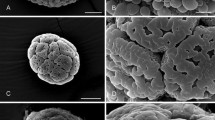Abstract
The highly specialized, two-celled hairs fringing the anthers ofCyclanthera pedata (L.)Schrad. and its relatives aid in pollination by producing a glue which sticks the coarse pollen grains onto insect visitors. This was proven by direct observations, confirming older assumptions. The adhesive is extruded from the big basal cell which bursts upon the slightest touch to the small top cell.—Turgor and, possibly, swelling pressure of the sticky material, are responsible for plasmoptysis and ejaculation. Cell contraction is due to tension of cuticular clips and, to a minor degree, to elasticity of the pectinic wall. A preformed apical dehiscence line disrupts when the top cell is bent aside.—The anthers hairs of a flower develop synchronously. From light and electron microscopic observations, the adhesive appears not to be a product of internal secretion. It originates from the endopolyploid giant nucleus of the basal cell, which finally degenerates by liquefying and swelling. The numerous peculiar elaioplasts apparently do not contribute to the hair's function.—The anther hairs are homologous to, and possibly have evolved from the so-called explosion hairs occurring on the green parts of manyCucurbitaceae.
Similar content being viewed by others
Literatur
Barlow, P. W., 1975: The polytene nucleus of the giant hair cell ofBryonia anthers. — Protoplasma83, 339–349.
Barlow, P. W., Sargent, J. A., 1975: The ultrastructure of the hair cells on the anthers ofBryonia dioica. — Protoplasma83 351–364.
Chakravarty, H. L., 1966: Evolutionary trends inCucurbitaceae.—Bull. Bot. Soc. Bengal19, 77–84.
Eichler, A. W., 1875: Blüthendiagramme, Teil I. — Leipzig: Engelmann.
Halsted, B., 1888: Staminal oil glands of Cucurbs. — Bull. Bot. Dept. State Agricultural College, Ames, Iowa, p. 54–58.
Jeffrey, C., 1962: Notes onCucurbitaceae, including new classific. — Kew Bull.15, 337–371.
Jones, C., 1969: A revision of the genusCyclanthera (Cucurbitaceae). Diss. Indiana Univ. — Abstr.: Diss. Abstr.30 (11), 1970, No. 4936-13.
Kartashova, N. N., Nemirovich-Danchenko, E. N., 1968: A Contribution to the knowledge of the evolution of nectaries inCucurbitaceae Juss. — Bot. Žurn. (Leningrad)53, 1219–1225 (Russ.).
Kisser, J. G., 1958: Die Ausscheidung von ätherischen Ölen und Harzen. In:Ruhland, W., (Ed.): Handbuch Pflanzenphysiol.10, p. 110. — Berlin, Göttingen, Heidelberg: Springer.
Küster, E., 1956: Die Pflanzenzelle, 3. Aufl. — Jena: Gustav Fischer.
Leins, P., Galle, P., 1971: Entwicklungsgeschichtliche Untersuchungen an Cucurbitaceenblüten. — Österr. Bot. Z.119, 531–548.
Martínez-Crovetto, R., 1955: Sur une nouvelle délimination de la tribuCyclanthereae (Cucurbit.). — Bol. Soc. Argentina, Bot.5, 212–218.
Müller, H., 1873: Die Befruchtung der Blumen durch Insekten. — Leipzig: Engelmann.
Netolitzky, F., 1932: Die Pflanzenhaare. — In:Linsbauer, Handbuch d. Pflanzenanatomie4, 1. Abt., 2. Teil. — Berlin: Borntraeger.
Riss, M., 1918: Die Antherenhaare vonCyclanthera pedata (Schrad.) und einiger anderer Cucurbitaceen. — Flora111/112, FestschriftStahl.
Schmidt, G. W., 1917: Bau und Funktion der Siebröhre der Angiospermen. — Diss. Jena.
Schultz, A., 1974: Flora ill. Rio Grande do Sul8:Cucurbitaceae. — Bol. J. C. B.31 ser. Bot.1, 1–64.
Tschermak-Woess, E., Hasitschka, G., 1953: Veränderungen der Kernstruktur während der Endomitose, rhythmisches Kernwachstum und verschiedenes Heterochromatin bei Angiospermen. — Chromosoma5, 574–614.
Tschermak-Woess, E., Hasitschka, G., 1954: Über endomitotische Polyploidisierung im Zuge der Differenzierung von Trichomen und Trichozyten bei Angiospermen. — Österr. Bot. Z.101, 79–117.
Turala, K., 1960: Endomitotical processes during the differentiation of the anther hairs ofCucumis sativus L. — Acta Biol. Cracov. (Bot.)3, 1–13.
Turala, K., 1962: Cytological processes during the differentiation of the hairs ofEchinocystis lobata. — Acta Biol. Cracov. (Bot.)5, 151–169.
Wettstein, R. von, 1935: Handbuch der Systematischen Botanik. — Leipzig, Wien: Deuticke.
Zimmermann, A., 1922: Die Cucurbitaceen. Teil 1 und 2. — Jena: Gustav Fischer.
Author information
Authors and Affiliations
Additional information
Herrn Professor Dr.Walter Leinfellner zum 70. Geburtstag gewidmet.
Rights and permissions
About this article
Cite this article
Vogel, S. Die Klebstoffhaare an den Antheren vonCyclanthera pedata (Cucurbitaceae) . Pl Syst Evol 137, 291–316 (1981). https://doi.org/10.1007/BF00982793
Received:
Issue Date:
DOI: https://doi.org/10.1007/BF00982793




